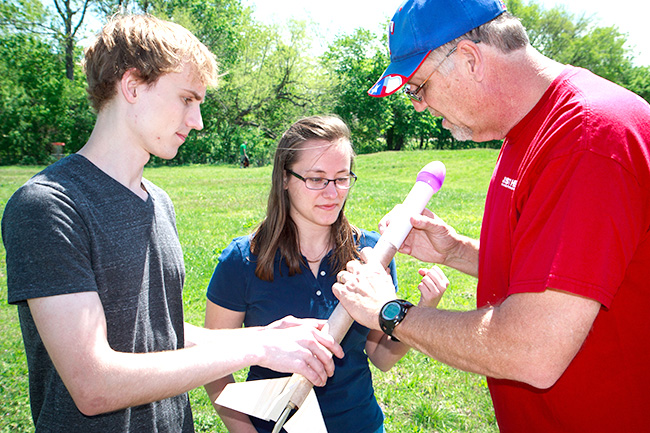
First place at the recent Society of Physics Students rocket competition went to this rocket, which achieved a height of 383 feet before returning to Earth with its egg payload intact.
To build and fly a rocket, you have to break some eggs.
That simple lesson came home for several students and faculty members at a recent model rocket competition sponsored by the UT Dallas chapter of the Society of Physics Students (SPS).
The SPS hosted the contest to engage the campus community and the public in a fun, creative and educational activity. The contest was open to anyone.
“Our aim was to get people interested in rocket science, and science in general,” said Joseph Coleman, a senior physics major and president of the UT Dallas SPS chapter.
Winners of the contest were chosen based on the height the rockets achieved, but with a twist.
“The rockets were required to carry and return a raw egg payload without breaking it,” Coleman said.
First place went to teammates Mikaela McMurtry, a UT Dallas junior in interdisciplinary studies, and Matt Henderson, a junior in physics. Their rocket achieved a height of 383 feet before returning to Earth with its egg payload intact.

Dr. Phil Anderson (right) assists Matthew Henderson, a physics junior, and Mikaela McMurtry, an interdisciplinary studies junior, to prepare their rocket for launch before it won first place in the competition.
“Matt said ‘Let’s build a rocket!’ and I said, ‘I’m intrigued; tell me more’,” McMurtry said.
“She’s an expert now – she’s a rocket scientist,” Henderson added.
Teammates Laura Hodges and Dr. Vlad Pozdin, a visiting scientist in the Alan G. MacDiarmid NanoTech Institute at UT Dallas, finished second with a height of 321 feet on the second launch of their rocket. The egg did not survive the rocket’s first launch.
Competitors received basic rocket kits about 10 days before the competition, as well as advice and an overview of rocket science from Dr. Phil Anderson, UT Dallas professor of physics at the W.B. Hanson Center for Space Sciences. Anderson, a member of the National Association of Rocketry, oversaw the launches during the competition.
At the event, Anderson assisted competitors in fitting each rocket with an altimeter to measure the height the rocket achieved, as well as an engine. After the engine expends its fuel, it releases a smoke trail for a specified amount of time. It then fires an ejection charge, which deploys a parachute that allows the rocket, egg and altimeter to be recovered.
“Ideally you want the parachute to deploy at the highest point in the flight,” said Anderson, who noted that some high-power model rockets can reach 50,000 feet.
The rocket contest was supported in part by a Marsh White Outreach Award that the UT Dallas SPS chapter received from the national organization. The award encourages projects that promote interest in physics among students and the general public.